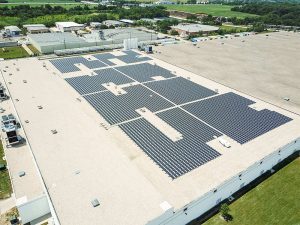How to Maximize A Commercial Solar Investment

A common question we get: I have a 100,000 sq. foot facility and my bill is around $100,000 per month. How much it would cost to install solar on my business?” Generally we need a few months of bills to develop an accurate solar quote. In fact, many business owners and facilities managers are surprised to learn just how many factors are factored to produce an accurate and honest purchase price.
To maximize your system’s performance and return, a good solar design and installation professional will look at much more than just square footage and average monthly bill. The best systems must address your business’ unique energy consumption patterns throughout all four seasons of the year and at various times of the day depending on where you are located. In other words, how much electricity you use every month, day, and hour can have an even greater impact on system design and price than simple square footage or roof orientation.
Like any big purchase, the best results happen when you explore all the contributing factors fully, and then align your design, goals and financing options accordingly. Luckily with Solar One, we have a proprietary model that achieves immediate cash flow by month one. To help get you started, here are the leading four factors that dictate the size, price and ultimately the ROI for almost every commercial solar investment.
Your energy consumption patterns
This is probably the most important consideration because it is specific to your company. How much electricity you use and when you use it is critical because utility costs fluctuate throughout the day. It matters when you’re running cold storage, or powering a production line. These patterns are unique to your operations, and also the reason why any other business operating in your same 100,000 square foot facility is likely to have a totally different electric bill. For these reasons, it’s important for your commercial solar consultant to fully review your previous 12-months of billing and usage history in order to design a system that fits your specific energy consumption patterns. This will impact the number of panels you need to purchase, price, and ultimately your ROI. If your company has tax liability, they can leverage this to purchase a solar array through our program with immediate positive cash flow.
Roof Condition and Orientation
There are two very-important items to consider when installing a roof mounted system—whether it’s a ballasted or a penetrating roof system. First, your roof, and any solar panels installed on it, must not be obstructed by trees, large air conditioning units or any adjacent structures. Second, your roof must be in good condition. While solar panels will typically extend the life of a roof by shielding it from elements, they may require removal to replace a roof that’s already in poor shape (especially in areas with snow). You’ll maximize your ROI by ensuring that the roof is in buildable condition before the panels are installed. As for orientation, a south-facing roof will capture the most mid-afternoon sun, which is best for many utility plans, but a west-facing orientation can be beneficial at offsetting utility power during high-demand on-peak hours later in the day. Ultimately, the best performing solar energy system is designed to address your specific usage patterns and utility rates. All of these variables will influence the configuration, and price of your solar energy system.
Your local utility provider
Solar panels stop generating electricity when the sun sets. Battery systems can be used to store solar energy for use at night, but even today’s best batteries are limited with capacity and still fairly costly. In the vast majority of cases, it’s most economical for business owners to simply offset purchased utility power during the day with their own solar energy system, and then utilize grid power at night when the sun is gone. While each utility has unique pricing models, the vast majority offer much cheaper rates during nighttime hours. So going solar will still have a dramatic impact on your bill even though the panels are only operational during the day. Designing a solar energy system to optimize the on-peak / off-peak times in your utility district is critical to generating an accurate purchase price and honest ROI estimate.
Payment options and tax incentives
There are many traditional ways to fund a commercial solar purchase, including leasing, loans and, of course, cash. With Solar One, we present a unique option that maximizes savings for our customers while they own the solar array, instead of sharing the benefits with a 3rd party.
In addition, there are both national, state tax incentives and even Department of Energy grants that can offset more than 26% of a solar purchase. And for certain types of businesses – such as agriculture—there are even federal grants available for renewable energy projects. In short, there are many creative ways to combine all of these options to best suit your company structure, personal finances and solar energy goals while saving you a ton of money! Our solar consultants are well briefed on all available programs and able to provide multiple options for you to choose from.
This is hardly a comprehensive list. While these four factors are probably the most important, there are many other secondary considerations as well. We recommend getting a customized quote from a certified solar installer as the best way to learn how much solar can save your family now and in the future.
Contact Com-Sol today for a free solar evaluation and to find out about additional programs in your area and how our proprietary energy savings program can cut costs immediately for your operations.
Other Useful Resources
Common Commercial Solar Financing Models
Illinois Solar Incentives
Solar Energy FAQ
Solar Power Vocabulary 101